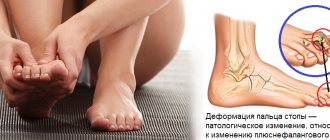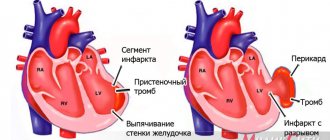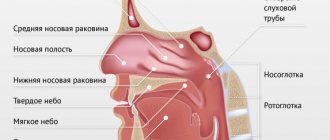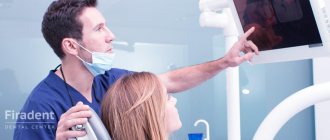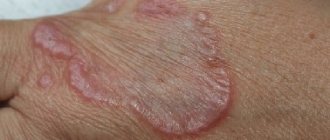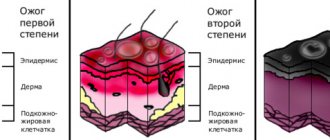Cyanosis and “blue” defects
What is "cyanosis"? Why does it occur? What to do with him?
In previous chapters, we described “pale” defects, in which arterial blood, through a defect located inside or outside the heart, enters the venous system and mixes there with venous blood. A “left-to-right” reset is formed, i.e. from the left chambers of the heart to the right.
With the defects of the group that we now want to examine, the opposite picture occurs: venous blood enters
the arterial system
and mixes with
oxidized arterial blood
. That is, there is a “right-to-left” discharge, from the right parts of the heart to the left.
Children suffering from these types of defects differ from healthy ones in the bluishness of the skin and, especially, mucous membranes, which look crimson-red or purple, as if the child had eaten blueberries. Noticeable blue discoloration may appear immediately after birth, or may appear several weeks or even months later, and can be of varying degrees. Why is this happening?
The fact is that arterial blood receives, through a defect in the heart, an admixture of purely venous, oxygen-poor blood. As a result, this blood is constantly undersaturated, and there is not enough oxygen for the tissues.
The body fights this in a simple way: the bone marrow and spleen produce more blood cells - red blood cells, which carry this oxygen. Their amount in the blood is significantly higher than normal. of hemoglobin increases
, which they contain, is actually the substance to which oxygen molecules are attached in the pulmonary alveoli.
The greater the admixture of venous blood to arterial blood, the more red blood cells and hemoglobin there are in the blood. This is a protective reaction that allows cells of organs and tissues to live, despite the low oxygen content in the incoming blood.
But such a disturbed composition also affects the appearance of the skin and mucous membranes, since their vessels are filled with thick and dark blood: after all, an increase in the number of red blood cells makes the blood thicker, and the blood flow in the capillaries slows down.
The consequences of this condition are dangerous. In children, small blood vessels can become clogged, especially in the brain. As a result, areas of insufficient supply to certain areas of the brain may develop and neurological symptoms may appear. Due to insufficient oxygen supply to the areas of the body furthest from the heart—the tips of the fingers and toes—they not only begin to change their color, becoming bluish, but also thicken at the ends (the so-called “drumsticks”), and the nails become enlarged and become convex (the so-called “watch glasses”).
In patients with defects in which the “right-to-left” discharge is accompanied and enhanced by an obstruction to blood flow in the right ventricle, dyspnea-cyanostic attacks appear when the child loses consciousness for several seconds, and sometimes minutes, and cannot inhale a sufficient amount of air. This is already very scary, because it can turn into a long-term and sometimes irreversible loss of consciousness. So the very existence of cyanosis is dangerous at any age and it is absolutely necessary to get rid of it surgically.
Depending on the degree of mixing of venous and arterial blood, the degree of cyanosis can be very different. Sometimes the child’s entire body is “blue”, sometimes only the lips and tips of the fingers and toes. With some defects, cyanosis does not become noticeable immediately, but several weeks or months after birth. In other words, a defect that was “pale” in infancy becomes “blue.” This does not mean that something happened to the child. It’s just that with growth, the “right-to-left” discharge has become larger. And please keep in mind: while a “pale” vice can become “blue” over time, then a “blue” can only
using surgery.
How to get treatment at the Scientific Center named after.
A.N. Bakuleva? Online consultations
Causes of cyanosis
Whether constant cyanosis is characteristic of a particular disease or is transient in nature depends on the cause of its occurrence.
If after examination the cause of cyanosis of the skin cannot be determined, then it is called primary, or idiopathic.
Cyanosis may not have a pathological basis, but in order to protect the patient, it is necessary to undergo an examination and exclude organic pathology. Secondary cyanosis occurs as a result of some disease.
Central cyanosis most often occurs in respiratory failure, when there is high pressure in the pulmonary arteries, pathology of the bronchi, lungs, or if the patient has a congenital defect of the interventricular or interatrial septum. The most intense cyanosis will be in those areas where the skin is the thinnest; for example, cyanosis of the lips will be characterized by an almost purple color. A characteristic sign is also cyanosis of the nails.
Peripheral cyanosis is more often observed in patients with heart failure, as the speed of blood flow is significantly reduced. Areas of the body that are exposed to low temperatures have a bluish color.
Diagnostics
To identify the cause of cyanosis, the doctor determines the area of its localization, listens to the patient’s complaints and analyzes his medical history. The following points must be clarified:
- when and under what circumstances did cyanosis occur;
- how the bluish tint changes during the day or under the influence of some factors;
- cyanosis appears constantly or periodically.
After this, the specialist listens to the lungs and heart. To obtain more detailed data, the following types of laboratory and instrumental diagnostics may be prescribed:
- blood gas analysis;
- clinical blood test;
- pulse oximetry;
- spirography;
- ECG;
- chest x-ray;
- Echo-CG;
- CT scan of the chest.
After diagnosis, the patient may be recommended other types of examinations to create a more effective treatment plan for the underlying disease.
Treatment
Therapy depends on the specific pathological process. Let's look at the problems in order with possible solutions:
- Heart defects. The operation is indicated. Plastic or prosthetics. For example, replacing a valve with an artificial one. There are no other options.
- Myocardial inflammation. Antibiotics and beta blockers are prescribed to relieve rhythm disturbances. If necessary, use cardioprotectors (for example, Mildronate).
- Functional deviations from cardiac structures. Protective agents (Riboxin and analogues), antiarrhythmics, and beta blockers are indicated as support measures.
- Coronary insufficiency. The same drugs are used. Plus, you need to find the root cause and eliminate it.
- Heart attack. The list is the same. Additionally, organic nitrates (not always), vitamins are used, and intravenous infusions of solutions are performed.
- Asthma. Bronchodilators (Berodual and similar), inhaled corticosteroids, oral hormones (Prednisolone and others), first and third generation antihistamines (Cetrin, Suprastin, Tavegil).
- Inflammation of the respiratory tract. Antibiotics, antivirals, hormonal drugs and similar.
- Respiratory failure. Glucocorticoids, bronchodilators. They look for the primary cause and carry out correction. In extreme cases, the patient is connected to a ventilator.
- Anemia. Iron supplements, B vitamins, also need to eliminate the cause of insufficient absorption of nutrients.
- Poisoning. Detoxification measures, introduction of antidotes. The correction is carried out in the hospital.
- Atherosclerosis. Statins, fibrates, nicotinic acid, special diet, giving up bad habits.
- Thrombosis. Antiplatelet agents, anticoagulants, also thrombolytics.
- Drug addiction and alcoholism. Detoxification measures, coding, rehabilitation.
- Infections. Antibiotics, anti-inflammatory drugs, analgesics, antipyretics, as well as antiviral and immunomodulators are prescribed.
There are a lot of options. The strategy needs to be developed individually.
Development mechanism
The pathogenesis of the pathological process is based on a group of factors. If we talk about them in a generalized format:
Breathing problems
They are especially common. In this case, the oxygen concentration itself decreases. During biochemical processes, carbon dioxide is released into the riverbed. This is a harmful, waste product. It needs to be brought out faster.
And this is where the problem arises. Not only are the lungs unable to deliver enough oxygen, but they are also unable to eliminate harmful gases that are toxic to the body.
The concentration grows, poisoning of all tissues and systems of the body begins. Need urgent medical attention.
Cardiovascular disorders
Another common factor in the development of the pathological process. There are a lot of diseases that cause cyanosis. Often we are talking about heart defects and functional disorders.
It makes sense to check this part with a cardiologist. The mechanism is based on a violation of blood transfer, its stagnation in the large and small circles.
Hence dysfunctional disorders. The heavier they are, the worse the situation is overall.
Blood abnormalities
In some cases, red blood cells themselves are not able to combine normally with oxygen and form full-fledged hemoglobin. This leads to the accumulation of carbon dioxide, which begins to poison the patient's entire body.
As a rule, the problem is acquired, but there are congenital types of the disorder.
It is necessary to approach the diagnosis carefully. A hematologist works with patients of this profile.
Endocrine disorders
Deviations from hormonal levels. They are extremely common. In this case, the tissues themselves are unable to normally receive and absorb oxygen. They produce carbon dioxide as usual.
The concentration of carboxyhemoglobin increases several times. Cyanosis is pronounced and clearly visible. Treatment is very difficult.
Intoxication processes
In case of poisoning with salts of heavy metals, vapors of acids and volatile compounds, cellular respiration is disrupted. Rapid ischemic processes occur that pose a danger to life and health. Urgent inpatient correction is needed.
These are the basic mechanisms of the problem. Typically they occur individually and not as a system. There are exceptions to what has been said.
How to deal with cyanosis?
This pathology is not treated as a separate disease, since the symptoms indicate the presence of a more serious anomaly. Restorative measures are aimed at diagnosing the root cause and getting rid of the main pathological process. If the patient feels a constant lack of air, oxygen therapy is used. With regular use of the mask, the color of the fabrics is gradually restored, which indicates the effectiveness of the measure.
At risk are people who regularly consume ethanol-containing drinks, abuse inhalation of nicotine and combustion products, do not follow a diet, abuse fatty foods, are regularly in stressful situations, have an old post-traumatic condition of the lower extremities, diabetic syndrome, frostbite, varicose veins, maintain a regime of activity and proper rest.
Symptoms of the anomaly
The disorder has the ability to affect both the entire body and individual areas of the body. With a general anomaly, the following symptoms appear:
- blue color of tongue;
- discoloration of the epidermis;
- There is no change in temperature in the affected areas.
Cyanosis on the periphery looks like cyanosis of individual areas, while the tongue does not change color, and the temperature of the affected areas decreases.
